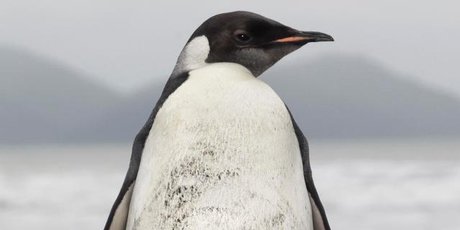WELLINGTON (AFP) – An Emperor penguin that washed up
lost on a New Zealand beach this week was taken to Wellington Zoo Friday
after its health deteriorated, wildlife experts said.
The penguin, nicknamed "Happy Feet" by locals, was found wandering on a
North Island beach on Monday, more than 3,000 kilometres (1,900 miles)
from its Antarctic home.
The giant bird, only the second Emperor penguin ever recorded in New
Zealand, initially appeared in good health but Department of
Conservation (DOC) spokesman Peter Simpson said it took a turn for the
worse early Friday.
He said the penguin, which is used to sub-zero temperatures, was eating
sand in an apparent bid to cool down. Emperor penguins in the Antarctic
eat snow when they get too hot.
"It was eating sand and small sticks, it was standing up than lying down
and attempting to regurgitate the sand," Simpson told AFP.
"We had the vets and an expert from Massey (University) examine it and
we've decided to take it to Wellington Zoo to see if we can find out
what's wrong with it."
Simpson said if the penguin, believed to be a juvenile male, could be
nursed back to health, it may be reintroduced to the sea in the hope it
will swim back to Antarctica.
He said the worst case scenario was euthanasia, adding "that's not one we're looking at at the moment".
The penguin attracted hundreds of sightseers to the Kapiti Coast, 40
kilometres north of Wellington, although Simpson said the crowds had
been responsible and kept their distance from the bird.
But he said the Emperor was stressed by the relative warmth of the New
Zealand climate, where temperatures are currently around 10 degrees
Celsius (50 Fahrenheit).
"The problem with these birds is that temperature control is vital and
the stress levels need to be monitored very closely," he said.
Earlier this week, Simpson said flying the penguin back to Antarctica
was not feasible as the frozen continent was in the midst of winter and
it was dark 24-hours a day.
He also said there were no facilities in New Zealand capable of providing the bird with long-term accommodation.
The Emperor penguin is the largest species of the distinctive waddling
creatures and can grow up to 1.15 metres (45 inches) tall.
They live in colonies ranging in size from a few hundred to more than
20,000 pairs, according to the Australian Antarctic Division.
With no nesting material available on the frozen tundra, they huddle
together for warmth during the long Antarctic winter, as depicted in the
Oscar-winning 2005 documentary "March of the Penguins".
The penguin found in New Zealand is named after the 2006 animated feature "Happy Feet", about a tap-dancing Emperor chick.
Source
Penguin strong but given 50/50 chance
KAY BLUNDELL
Wellington Zoo
The emperor penguin - nicknamed Happy Feet -has some of the sand he consumed flushed out by Wellington Zoo staff.
ROSS GIBLIN/Dominon Post
An emperor penguin a long way from home on Peka Peka Beach, Kapiti Coast.
ROSS GIBLIN/Dominon Post
An emperor penguin a long way from home on Peka Peka Beach, Kapiti Coast










(For more images on the slideshow and to see the video shown below, click
HERE
Penguin removed from beach
The emperor penguin taken from Peka Peka beach is to undergo surgery
tomorrow, with zoo staff giving it a 50 per cent chance of recovery.
'Happy Feet' was earlier taken to Wellington Zoo in a chilled box
from the Kapiti Coast after the penguin's behaviour changed markedly in
the last few days.
Veterinary staff at the zoo said the bird was dehydrated and was suffering from heat exhaustion.
It needed to be stabilised before being operated on, but would this
afternoon undergo a manual procedure to try to clear its throat, which
seems to be blocked.
The penguin was put under anaesthetic this afternoon while vets flushed sand out from inside its body.
Wellington Zoo vet science manager Lisa Argilla said he was a spirited bird and the team was doing their best for him.
"He's still strong and he's got a lot of fight in him, which is good," Argilla said.
"Every animal is important to us. We don't really want him to suffer.
"I'm hoping its just a piece of driftwood that we can reach down and pull out."
As for the future, the zoo was still discussing the best course of action with the Department of Conservation (DOC).
While the best solution would be a return to Antarctica, there was
also a facility in the USA which deals particularly with emperor
penguins.
Returning the bird to Antarctica was not feasible because there was
no transport there in winter and experts advised that large birds could
suffer trauma if transported long distances.
Zoo staff said the last emperor penguin to come to New Zealand was released in Foveaux Strait.
DOC biodiversity manager Peter Simpson said the penguin had been
eating sand, which may have been an effort to cool itself down, as
penguins normally eat snow if they get too hot.
Simpson said it had become lethargic and that it might have an infection from eating sticks.
The bird was first spotted on Peka Peka Beach on Monday afternoon by
resident Chris Wilton, who nicknamed it Happy Feet, and has since
attracted local and global interest.
A cordon was put up around the penguin during the week, keeping
people about 40m away due to high numbers of sightseers, with a group of
residents even keeping guard on the beach overnight.
Kapiti Coast District Council also assigned a security guard to prevent harm to it.
It is the second recorded incident of an emperor penguin on New Zealand shores.
- Michelle Duff, The Dominion Post and Stuff
Source



































































